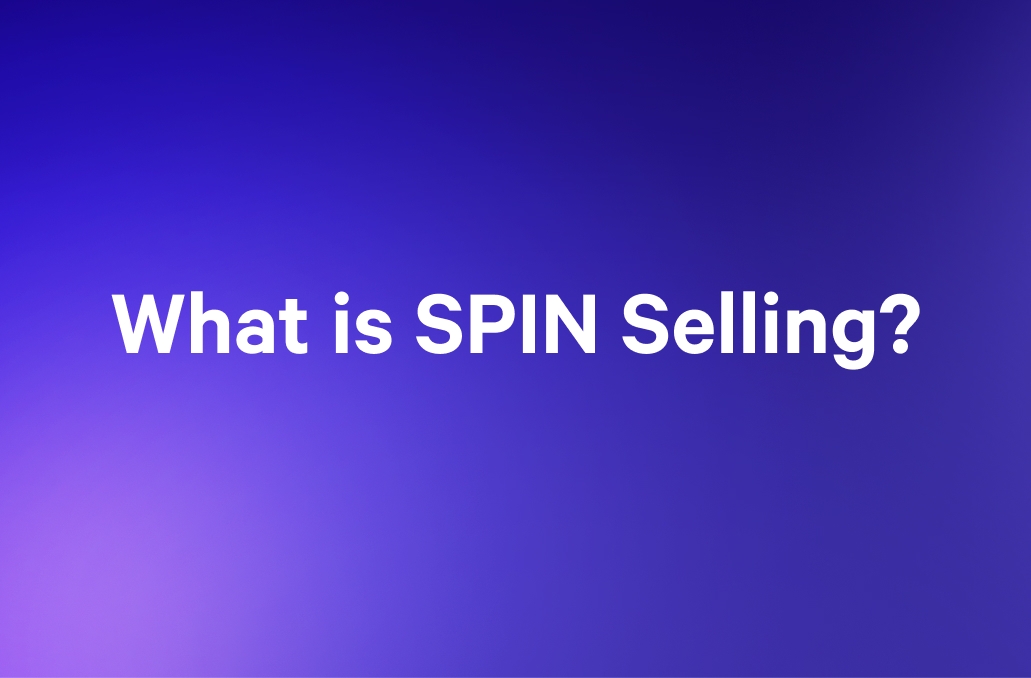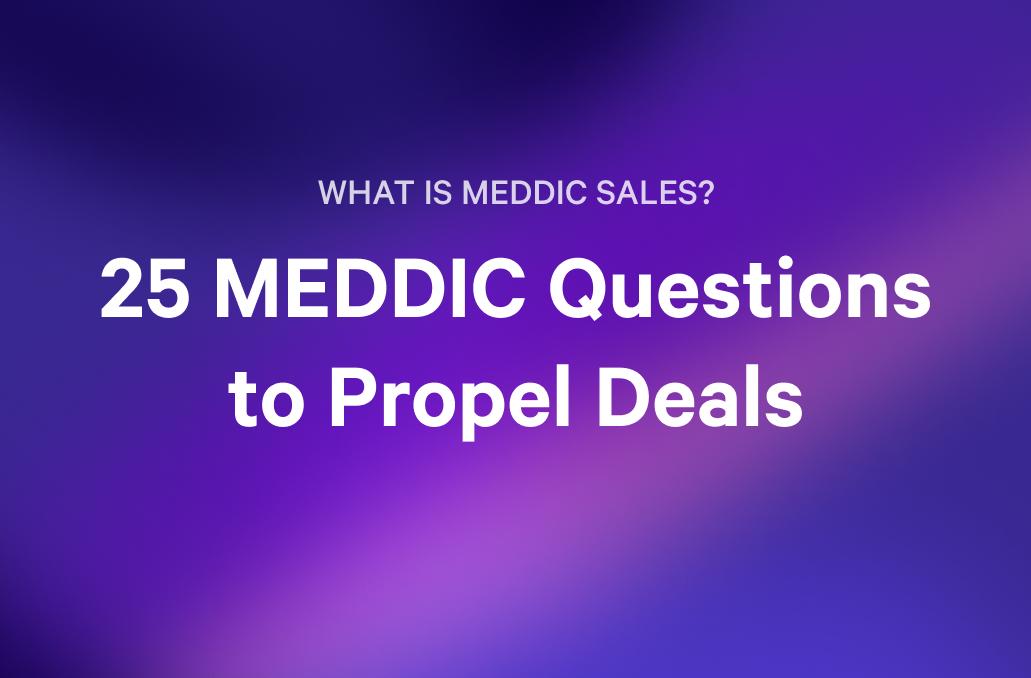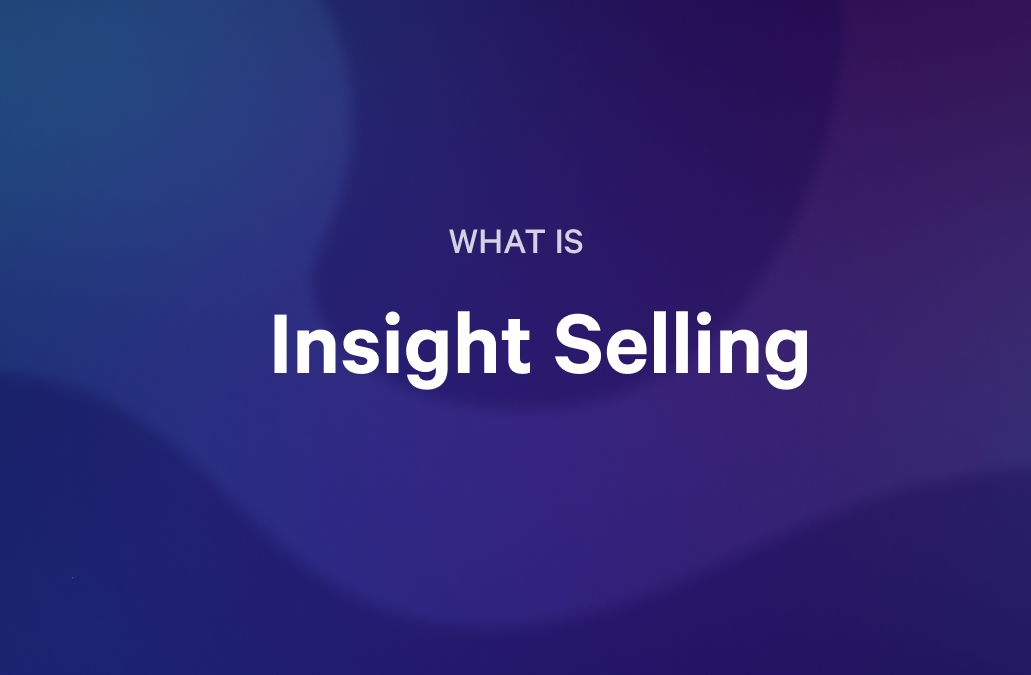Top-performing sales teams don't just rely on fleeting tactics. They build on proven frameworks that continuously evolve to meet new challenges. One such methodology that has gained traction is MEDDPICC—a refined approach offering deeper insights into the complex sales process.
MEDDPICC builds upon the foundations of the MEDDIC methodology, adding critical steps to ensure a thorough exploration of every facet of the decision-making journey. This comprehensive framework enhances your ability to effectively address prospect needs, navigate decision cycles, and successfully close deals.
Let's dive into the intricacies of MEDDPICC and discover how it can be seamlessly integrated into your sales strategy.
What is MEDDPICC?
MEDDPICC is a robust sales methodology designed to qualify opportunities early in your organization’s sales process. Using this framework can boost close rates in theory because it keeps misaligned deals from moving too far down the sales pipeline.
MEDDPICC stands for:
- Metrics: How the prospect measures success.
- Economic Buyer: The person with the purchasing authority in your client or prospect’s organization. While there is a lot of research on buying groups, much of what we know (and what MEDDICC confirms) is that this role is typically played by one person in the group, so it’s critical to identify this individual early in the process.
- Decision Criteria: The conditions used to evaluate your product or solution when making a purchase decision.
- Decision Process: The process the organization goes through to make the decision. This could be a formal request for proposal process (RFP) or a more informal series of meetings, calls, and presentations with a formal (or written) proposal.
- Paper Process: Paper process speaks to the process the customer will take to complete the purchase. It also sometimes refers to the contract later in the deal and the sales rep’s ability to track expiration and renewal dates or make amendments to the initial agreement for new products or services.
- Partners: Sometimes, another P in MEDDPICC is for partners – are there any strategic partners who are part of the deal? For example, it's common in IT sales for a value-added reseller or distributor to play a role in the sales process.
- Identify pain: What pain point is the prospect looking to address with your solution?
- Champion: The person (or group of people) internally advocating for you and your product or service.
- Competition: The second C in MEDDPICC is for competition. In this expansion on MEDDIC sellers are asked to consider their competition carefully. This may be direct competitors or other things that can take your prospects time, attention and budget.
- Compelling event: Another C that is sometimes considered in the MEDDPICC process is compelling event. In this step the seller is looking at compelling events that could drive a prospect to take action (or keep things status quo).
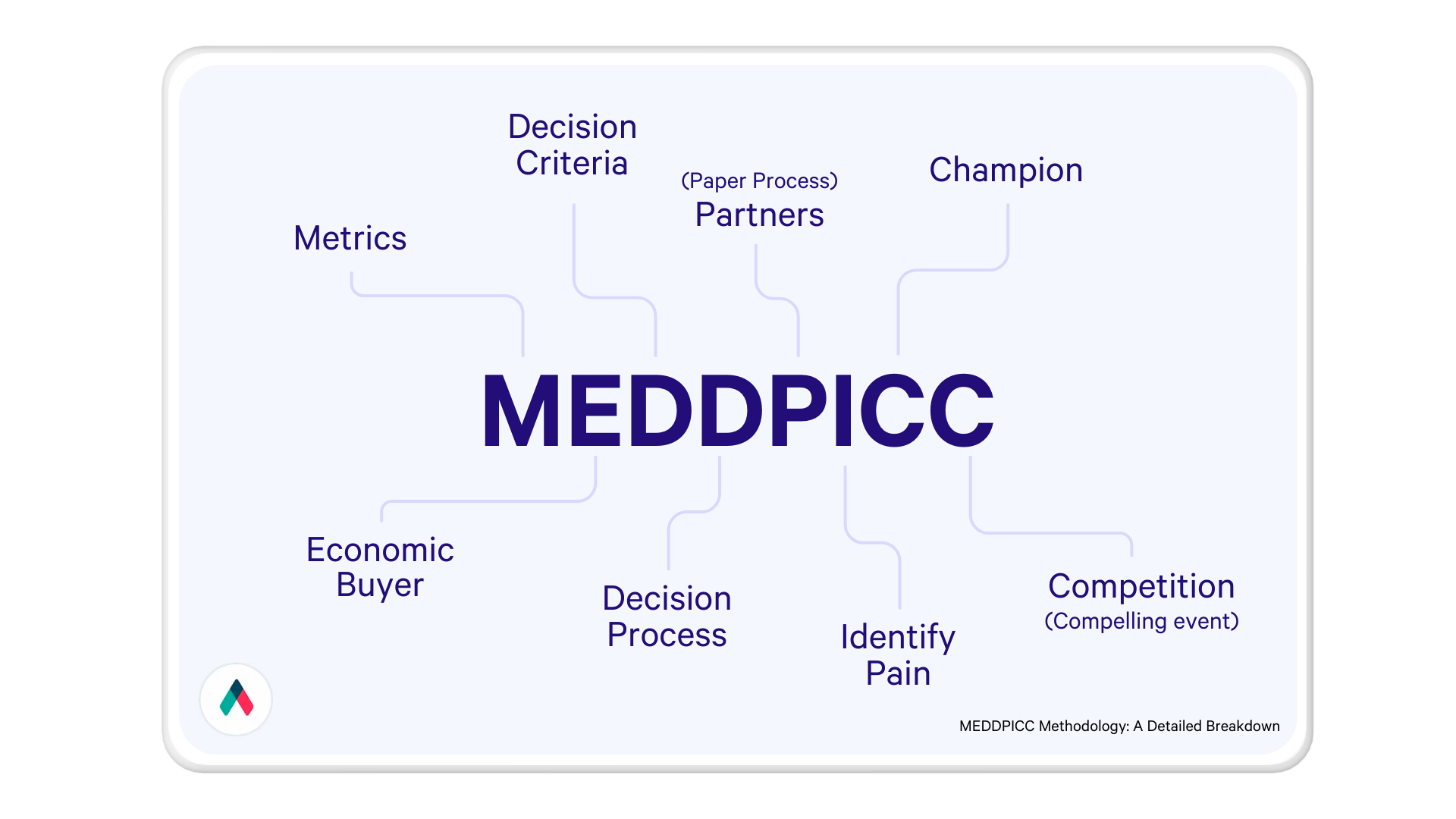
What are the benefits of using the MEDDPICC methodology?
The MEDDPICC methodology stands out as an exceptional sales qualification framework because it empowers sales professionals to determine quickly and accurately if an opportunity aligns with their solution. By requiring comprehensive information gathering at the onset, it streamlines the evaluation process, making it easier to gauge whether a deal is likely to proceed.
For example, suppose a sales rep discovers that a decision maker hasn't been appointed yet, and the decision criteria and process are loosely defined. In that scenario, the buying process may not progress in a timely manner. Consequently, the sales rep might decide to disqualify the opportunity and redirect their efforts toward other deals that meet the criteria or focus on building additional pipeline.
Some other notable benefits of the MEDDPICC methodology include:
- It adds structure to gathering the right information, enabling even less experienced sellers to perform effective discovery and gain critical insights into deals.
- It ensures consistency across sales reps, facilitating the sharing of best practices and learnings within the team.
- It enhances sales forecasting accuracy, allowing sales teams to manage their pipelines more effectively and predict outcomes more reliably.
Read next: Miller Heiman sales process
MEDDPICC VS MEDDIC
MEDDIC is a comparable sales qualification methodology but lacks two critical criteria present in MEDDPICC: paper process and competition.
MEDDIC is well-suited for more straightforward sales opportunities where the paper process is either unnecessary or overly simple. It is also ideal for new and disruptive technologies, especially when competition is less of a focus or there are no established competitors yet.
One of the standout qualities of both MEDDIC and MEDDPICC is their flexibility. These methodologies can be tailored to fit your organization’s specific needs, providing the essential insights required about potential customers.

How to use the MEDDPICC sales framework
Implementing MEDDPICC doesn’t have to be overly complicated. If you’re already familiar with MEDDIC, integrating the two additional criteria—paper process and competition—should be relatively seamless. However, if you’re entirely new to this type of framework, it might take some time to bring your sales team up to speed.
To help you implement the framework and start better qualifying opportunities, here are some actionable steps to get started:
1. Drill down on the most common metrics
While your prospects may all use unique metrics to quantify the impact of your solution, over time, you'll notice recurring themes. For instance, if you sell project management software, you might identify key outcomes like greater collaboration, faster project delivery times and more visibility for leadership.
Understanding these metrics not only helps you tailor your pitch to each prospect but also allows you to identify which outcomes resonate most within your target market.
2. Ask about the economic buyer
Sometimes the economic buyer is easy to find, and other times it’s like looking for a needle in a haystack. In the early stages of MEDDPICC selling, you want to make sure you or your team are asking questions that lead to identifying the economic buyer. This might be as simple as asking things like:
- Who is the final approver in the purchasing decisions in your company?
- I know we met with Sarah, Jennifer, and Brian to discuss the opportunity; who is responsible for determining the next steps and selecting the final vendor?
- If the entire team has agreed on a solution, is there someone who has to approve it before it’s considered a final decision? Can we meet with that person to introduce ourselves and learn about their needs?
Identifying the economic buyer early on can significantly streamline the decision-making process and move your deal forward efficiently.
3. Brainstorm common decision criteria
Like metrics, decision criteria may also have some themes across prospective clients. This is especially true in larger, more complex enterprise sales involving procurement teams. There might be some baseline criteria that are used to evaluate your solution.
Let’s use our project management software as an example again. In order to be considered, procurement might be looking to ensure that your software has a view where a project manager can see all of their active projects at a glance and understand the health of these projects using a red-yellow-green signal to highlight projects on track, at risk, or in jeopardy. It might also be on the list of decision criteria that each user has a view where they can see all of their tasks (and only their tasks) across projects.
Getting ahead of common decision criteria is another way to help speed up the sales process and identify places you can speak to competitive advantages, but never skip the due diligence of ensuring you know ALL of a prospect’s decision criteria. This way, if you see something on the list that you know your solution doesn’t or can’t provide, you can easily remove yourself from the sales process before sinking too much time and effort into a sales pitch that can’t win.
4. Discover the decision process
Shopping for a product or solution can be a personal process for any buying organization. So just like you want to understand the decision criteria (what your prospect is looking for), you also want to understand their evaluation and decision-making process.
Having visibility into this process is a little like having a crystal ball. Once you know how you will be evaluated, you can plan your attack to support the process best. Let’s say you know the key stakeholders have packed calendars and can’t attend sales demos all the time. The organization has asked the committee to take half a day to meet with potential solution providers, and from there, the top three will be asked to put together a formal proposal.
You know you’re only going to have 20 minutes to make your pitch to the group, in order to get the green light to continue in the process. You already know that your solution checks every box in the decision criteria, and you’re clear on who the economic buyer is. You do a little more research before the presentation to learn everything you can about the buying committee and its goals.
This way, you can use your 20 minutes to tell the most impactful story and help the team move you to the next step, and much closer to closing the deal!
5. Prepare for the paper process
Oh, paperwork, it’s every salesperson’s favorite part of the job (we kid). But, when you’re using the MEDDPICC framework, you do want to prepare for all of the paper that’s coming your way. It starts with the procurement process.
- Do you know what type of paperwork will be required when the prospect green-lights the deal?
- Is a master services agreement(MSA) required in addition to a contract or statement of work?
- Are there any specific terms, clauses, or disclosures the prospect’s procurement or legal team requires?
- Does the company’s procurement team have a maximum contract length they will agree to?
Getting these questions answered early (even as early as when you’re working on understanding the decision process) can help speed up the contracting phase and help you and your client get to onboarding more quickly.
But, the paper process isn’t over when the contract is signed. Especially in the SaaS world where salespeople need to keep track of the number of licenses (this may need to be adjusted frequently over the length of the contract), the contract terms and when the contract is set to expire. Timely contract renewals and proactive outreach before a contract is set to expire are other benefits of using this framework.
As part of understanding the decision process, sellers may want to ask about the process for contract renewals or extensions too. So, if a seller learns that a contract takes about six months to renew, they may put a task for themselves into their CRM or project management tool to start reaching out eight months before the expiration date to begin negotiations.
6. Identify (business) pain
Prospects have business pain, and we see sales success when we’re able to reduce or eliminate that pain. The more clearly a salesperson can find and address business pain, the higher their win rates are going to be.
Sometimes, you have to play detective to get to the root cause of the business pain. For example, let’s say you’re talking to a Director of Operations who tells you that they’re dealing with high employee turnover, especially among project managers and web developers. You dig in deeper and ask if any themes have come up across exit interviews.
Your prospect tells you that the project managers are feeling pressured by too many meetings and spending hours preparing complex status updates for project stakeholders that are incredibly particular. They don’t feel like they have enough time to look ahead and coordinate well with their internal teams.
The developers are confirming this story and leaving because they feel they’re not getting clear direction or tickets on project tasks, and it’s causing them to need to redo code and work late more often than not.
People are almost always willing to pay for a guaranteed solution. And as the sales rep, you know your project management software can help build customized dashboards to give stakeholders the information they need without the project managers spending hours in meetings and making reports. With your solution in place, the project managers and stakeholders will only need to meet when questions or issues arise, giving everyone more time to focus on their project work.
7. Seek out your champions
A champion isn’t just someone who likes you or your solution. This is a person who is going to sell your solution internally and help you navigate the sales process and organization.
A champion is someone who will:
- Give you access to the information you need to tailor your solution correctly
- Help you get face time with key stakeholders
- Sell your solution in the organization when you aren’t able to be in the room
- Advocates for your solution (and only your solution)
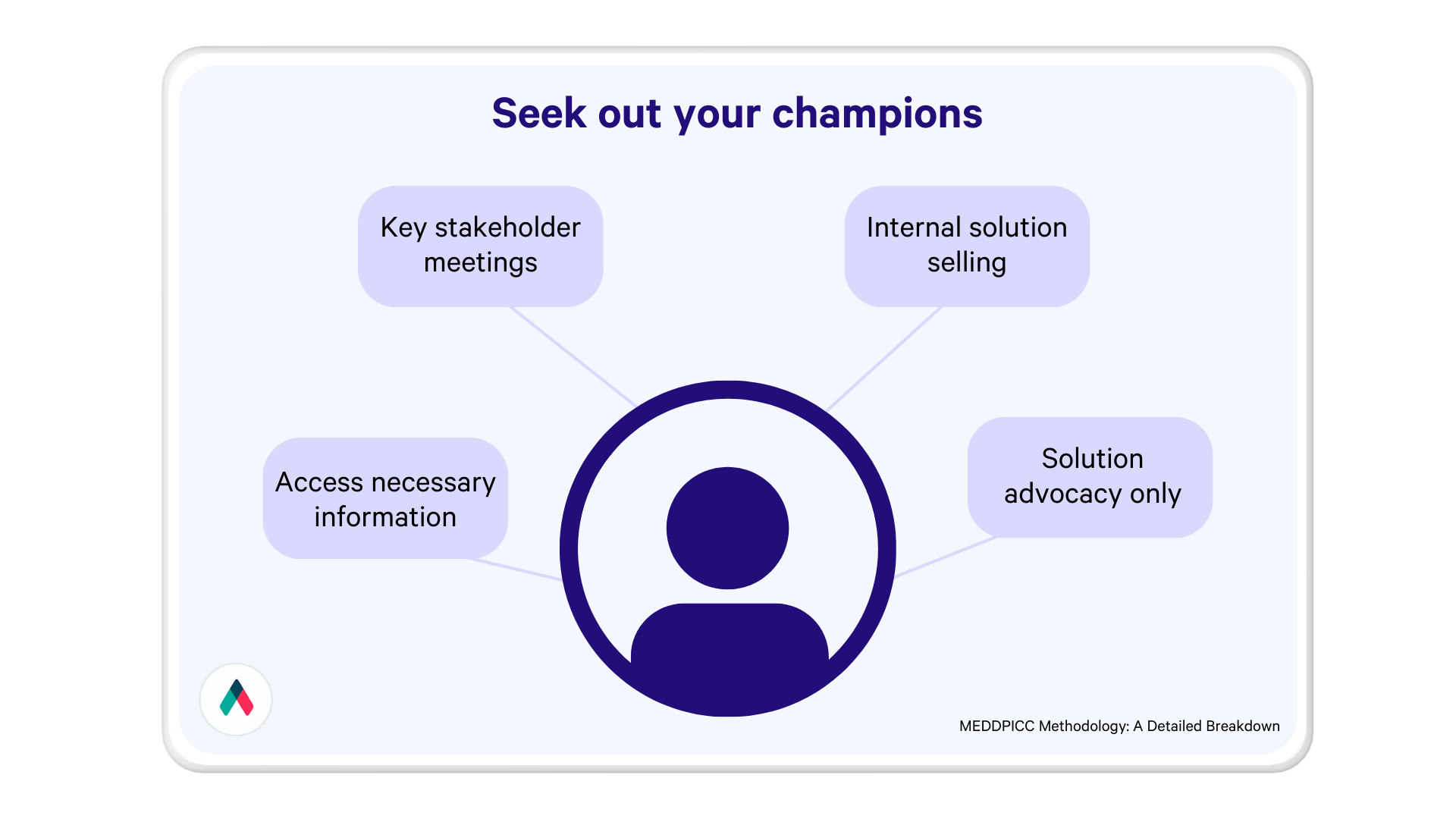
Finding (or confirming you’ve found) this person means giving them a test. If they can’t or won’t do one of the things listed above when you ask, you don’t truly have a champion. You might have someone who likes and respects you, but they are not your champion - so keep looking to see if you have one in the organization, or keep moving to other organizations where you have a champion.
8. Crush the competition
In order to crush the competition you want to learn everything you can about them. You can start by asking your champion if they would be willing to share with you who you are competing against.
If your organization regularly comes up against the same competitors over and over, your sales enablement team might have some resources to help support you. This might include battle cards with key messaging to help prospects see your competitive advantage.
Combining what you’ve learned going through your MEDDPICC process with what you know about the competition is a great way to create a strategy to win the deal.
MEDDPICC template example
For sales organizations who are already using MEDDPICC to qualify deals or want to start, Qwilr has an easy-to-use MEDDPICC proposal template that’s available for you to customize.
Our proposal template can serve as an example for sellers looking to compile a compelling proposal in line with the MEDDPICC framework. Using this template will ensure that the proposed solution aligns with what you have learned through the qualification process.
The format allows sellers to create documents that are easy for buying team members to read, understand and share. Using our MEDDPICC template, it’s easy to speak to each of the 8 steps in the process and have everything your prospect needs to see to make their buying decision.
Because Qwilr's proposal software can sync with most CRMs, all of that research you did and all of the data you have about your prospect can be seamlessly pulled into your proposal. Saving you time.
Looking to learn more about sales methodologies?
In our ongoing exploration of effective sales methodologies, we recently hosted an insightful webinar featuring industry experts Richard Harris, Founder of The Harris Consulting Group, and Nathan Clark, Director of Global Sales Enablement at UpGuard.
The discussion centered around the evolution and relevance of various sales methodologies in today's fast-paced selling environment:
You can also read our guides on other popular sales methodologies like:
- Gap Selling
- Spin Selling
- Transactional selling
- Solution selling
- Consultative selling
- Value-based selling
- Proof of Concept
- BANT
Looking to explore MEDDPICC right away? Get started with Qwilr’s MEDDPICC proposal template.
Closing more deals with MEDDPICC
When it comes to closing deals, preparation is key, and MEDDPICC gives sellers a step-by-step guide to prepare and strategize. Having a deep understanding of the prospect’s pain, metrics, processes and who the competition is in every deal helps sellers craft winning solutions and proposals to delight their prospects.
About the author

Marissa Taffer|Founder & President of M. Taffer Consulting
Marissa Taffer is the Founder & President of M. Taffer Consulting. She brings over 15 years of sales and marketing experience across various industries to a broad range of clients.
FAQs
The benefits of MEDDPICC are that it allows sellers to quickly qualify or disqualify opportunities before they get too far into the sales process and gives sellers a framework to start from. Another benefit of MEDDPICC (over MEDDIC) is that it addresses contract expiration (paper process) and competition.
MEDDPICC is different from MEDDIC because it adds two additional steps to the process. The addition of P, for paper process helps sales reps keep track of contracts, how they will be executed and when they expire. The additional C is for competition and asks sellers to seriously consider who they compete with throughout the sales process.
You will know if you should use MEDDPICC or MEDDIC based on your sales process, customer, and the product or services you sell. For example, in most enterprise sales situations that are highly competitive, MEDDPICC may be more suitable than MEDDIC because it asks the sellers to focus on evaluating the competition.
A compelling event in MEDDPICC selling refers to a specific occurrence or deadline that drives a prospect to make a purchasing decision. This could be an external event, such as a regulatory change, a contract renewal, a financial quarter end, or an internal initiative deadline that necessitates action. Identifying a compelling event helps sales professionals understand the urgency behind a prospect's decision-making process and tailor their approach to align with the prospect's timeline, increasing the likelihood of closing a deal within a specific timeframe.
MEDDPICC and BANT are methodologies for qualifying sales leads, focusing on different aspects. MEDDPICC offers a comprehensive guide through the sales process, emphasizing detailed understanding from economic buyer identification to competition analysis. Alternatively, BANT stands for Budget, Authority, Need, Timing, and prioritizes assessing a prospect's budget, decision-making power, product need, and purchase timeline. While BANT provides a quick qualification overview, MEDDPICC delivers a deeper, more nuanced exploration of sales opportunities.




